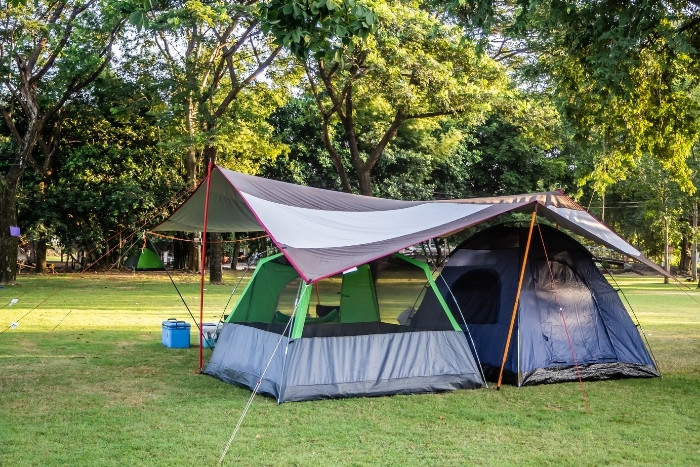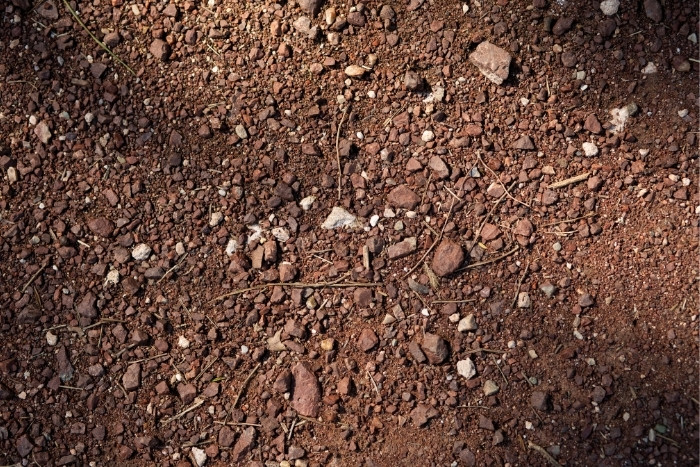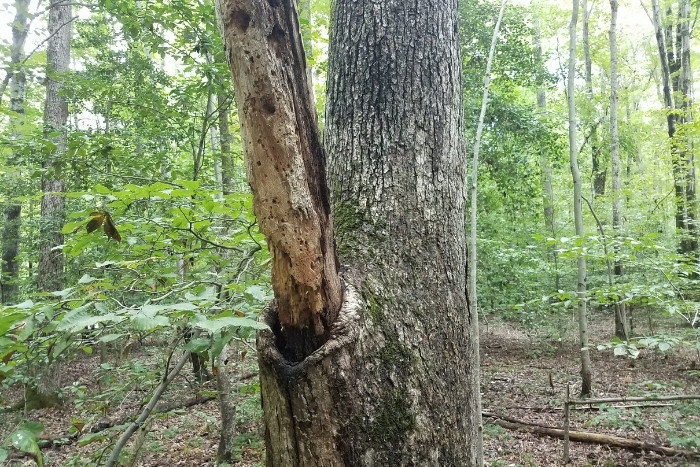The thrill of setting up camp, sleeping under the stars, and waking up to see the sunrise over the horizon is enough to make anyone giddy. And because camping involves spending time outdoors, you’ll want to choose a spot that offers protection from the weather, is well-lit, and is generally safe.
You need to look for a perfectly flat spot when pitching your tent. Even a spot that looks like it’s been used before. Ensure your tent is on good ground, not too soft or too hard, protected from weather elements, not too close to the fire pit, and not too close to other animal dwellings.
So without further ado, let’s look at a few ways to pick the perfect location for your next camping adventure. After all, this is an important aspect of camping, and you must make sure you choose the perfect spot to pitch your tent.
How to Choose the Perfect Spot to Pitch Your Tent
If you’re planning on pitching a tent in a large area, such as a field or park, you may find a good spot relatively easily.
However, if you plan on pitching a tent in more confined areas with a harsher environment, such as a forested area or a mountain, it can be difficult to find a suitable place.
1. You Need to Find a Flat Area
When choosing where to set up your tent, you should always consider how flat the ground is. If you have uneven terrain, you might not be able to get a tent set up properly.
This could lead to problems when trying to sleep, especially if you use a tent with a light padded floor. Either you’re not going to set up the tent correctly, or you’re not going to sleep well in it.
Several problems arise when you set up a tent in an uneven place. That’s why it’s always recommended that you set up the tent in a flat area.
However, something important that you need to ensure doesn’t happen; the tent shouldn’t be at the end of a slope. Even if it’s the flattest area you’ve seen all day, never set up a tent there.
When you set up your tent at the end of a slope, you will encounter all sorts of trouble. If it rains, all the water will get in your tent.
If debris falls from a tree, it may roll back onto your tent. This location is potentially dangerous, and you should avoid it.

2. Prepare For All Kinds of Ground Conditions
There are two types of ground conditions: hard and soft. When looking for a spot to pitch your tent, you must consider what type of ground you’re dealing with.
Ideally, the location shouldn’t be too hard or too soft; it must all be balanced. You don’t want to pitch your tent in a place with loose soil.
Loose soil means the ground will shift around during heavy rainstorms, which could cause damage to your tent.
It also makes it very easy for dirt or water to enter your tent, which could ruin your sleeping setup. You also don’t want to pitch a tent in a rocky place.
Rocks can break your tent poles and even crack your tent walls or the padding below. They can also cause damage to your tent if you accidentally step on them while inside, and they may also harm you.
On top of that, you won’t get a good night’s sleep if you’re sleeping on rocky terrain. As we mentioned earlier, it can also cause damage to the tent, tearing it and allowing water to come in.
3. Make Sure You’re a Safe Distance Away From the Fire Pit
If you’re camping near a fire pit, you need to ensure that you’re far enough away so that you won’t be affected by any smoke or flames.
The best way to do this is to keep a safe distance between yourself and the fire pit. Depending on the weather conditions, you may want to set up close to the fire pit to get some of the heat.
However, that’s not recommended. You must remember that the wind can blow the embers your way, which may cause the tent to catch fire.
Also, if you’ve set up too close to the fire pit, and there is some slight wind blowing the smoke into your tent, you may risk asphyxiation.
When smoke gets into your lungs, it can damage them by simply cutting off the air supply or irritating them chemically or thermally.
If those two reasons weren’t enough, you may trip on the tent stake wires and fall into the fire pit. You must set up the tent reasonably far from the fire pit.
Safety should be the number one priority rather than comfort.
4. Find a Location Where You’re Sheltered From the Elements
One of the most important factors when choosing where to pitch your tent is whether or not you’ll be protected from the elements.
For example, camping in an area prone to high winds, you must find a spot sheltered from the wind. The same goes for cold temperatures.
If you’re camping in an extremely cold environment, you need to find somewhere sheltered from the cold. This means you must look for a spot in a valley or other low-lying areas.
If you’re camping in the summer months, find a location that can help you get some shade. Usually camping under trees is going to help you with this aspect.
What better feeling than hanging out under the shade at your campsite in the middle of the day? It’s going to make your stay there that much more enjoyable.
It’s great if you can find a place with flat and soft enough ground that protects you from the elements. You should always use nature to help and benefit your camping experience.
Finding the perfect location may take some time, but it’s worth it.
5. Flatten Out the Spot Under Your Tent
We understand that sometimes you’re not going to find the best location, and there may not be enough time to search any longer, so you have to do what you have.
That being said, you can still make some changes to the ground, such as flattening it out and making it smoother.
Let’s take, for example, a nice area you found on higher ground that’s relatively flat but has some rocks that are a bit jagged.
You first need to try and remove those rocks or turn them so that the pointy end is not straight and won’t damage the tent or you.
If they aren’t movable, try to break off the pointy ends or throw dirt around to make the area flatter.
However, you should not only be worried about the rocks, which you can remove in most cases, but you also need to look out for large sticks, pinecones, thorny leaves, etc., that could potentially tear the tent fabric or cause injury.
Depending on the place and the situation you find yourself in, you will have to do some other flattening and maybe use other techniques.
One thing is for sure, though, that you need to have a flat surface area for your tent; otherwise, you’ll have problems.

6. Identify the Best Location and Lay Down a Tarp
Laying down a tarp below your tent will work wonders for you since it will protect you from unwanted water under the tent. There could be a slight natural stream after it rains, which could be problematic.
Waking up in your tent because you’re getting wet is one of the worst feelings. You also want to lay a tarp over the top of your tent because it will protect it from rain and snow.
In addition, it will keep the bugs away and prevent the sun from shining directly onto the tent. You will be fully protected from the rain from above and below, even if your tent might have some slight tears.
This is especially true if you’re camping where it snows often. A tarp will allow you to sleep comfortably without getting wet and keep you warm at night.
Every little effort you put into making your camping experience safer and more enjoyable will help.
7. Look Out For Animals That May Live Nearby
You must look for any animals near your site, especially under your tent, to ensure you’re not disturbing any animals. They may have their holes and homes in the ground or nearby.
Depending on what kind of animals are in your area can lead to a dangerous situation. For instance, if you’re camping near a bear den, you must be careful when setting up camp.
You don’t want to disturb them by moving around too much. If you see something suspicious, you must get out immediately. It’s better to be safe than sorry.
You know it’s time to move on if you see snakeskin or tracks. This is especially important when camping in an area with poisonous snakes.
Also, holes in the ground can be for chipmunks or squirrels, so you must watch out for those. It’s not only because they can be dangerous to you, but also because you don’t want to disturb the fragile wildlife.
Imagine if someone came to your house and blocked the door, you wouldn’t want that. You should apply the same courtesy to these animals.
8. Don’t Camp Too Close to a Water Source
This may sound counterintuitive because most campers would say that’s a good idea since you may run out of drinkable water and have a source nearby.
Depending on the type of water source, you may be in danger in certain situations. For example, if it rains a lot, the water source may turn into a flash flood which could be catastrophic for you.
So, consider this before deciding where to pitch your tent. Another thing to consider is contaminated water since there may be a lot of animals that come there and drink as well.
That means that you need to make sure you filter the water first before drinking. Also, you’re at a higher risk of encountering dangerous animals if it’s a known place for them to come and drink.
That’s why it’s important you are near a water source for obvious reasons but don’t set up too close; otherwise, it doesn’t work in your favor.
9. Be Aware of Rotten Branches
If you decide to set up camp under a tree, you have to carefully look at the branches of the tree and examine if they’re rotten.
Maybe try to move them around with a stick or something to get a feel for them. If they seem solid enough, then you can go ahead and set up your tent. Otherwise, you need to find another spot.
Always imagine the worst-case scenario, especially if there’s bad weather. The wind could cause large branches to fall off; we’ve seen it happen repeatedly.
Make sure that doesn’t happen or at least do what’s in your control.
You need to check for signs which can be holes in the bark of the tree, dead sections on the trunk or branches, discolored leaves, or if you see sawdust around the base of the tree.
This is serious and could put your life in danger, so don’t risk it. Take your time and look for these signs. It will save you from getting hurt or worse.

10. Avoid Setting Up Directly in the Sun’s Direction
You might be tempted to set up your tent directly in the sun’s direction because you want to enjoy some direct sunlight during the day. But, this isn’t always a good idea.
The reason is that when the sun shines directly on your tent, it heats up very quickly, which makes it hard for you to sleep comfortably after the sun is up.
The heat will rise inside the tent and cause you to sweat first thing in the morning, which is not enjoyable. To avoid this problem, you should choose a spot away from the sun.
Ideally, you should aim for an area that gets shade throughout the day.
Closing Thoughts
Now that you know how to find the perfect place to pitch a tent, you’ll be able to set it up anywhere easily. Just remember to follow the suggestions above, and you’ll be fine.
You just need to practice using these tips and tricks. This way, you’ll be able to stay safe and comfortable while camping.
